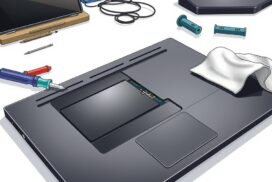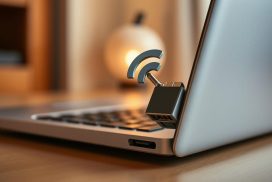Laptop Water Damage: Signs, Prevention, and Repair Techniques
Water damage can cause significant harm to laptops, whether it’s due to accidental spills, exposure to rain, or drops in water. Knowing the signs of water damage is crucial in order to take appropriate action and potentially save your laptop. Signs of water damage include leaking or dripping water from the laptop, keyboard and touchpad malfunctions, muffled or distorted speakers, network connectivity issues, random restarts or shutdowns, blurry or distorted screens, the blue screen of death, and the laptop not powering on.
Taking immediate steps such as turning off the laptop, removing the battery, and drying the device can help minimize potential damage. It’s important to avoid common myths, such as using a hairdryer or putting the laptop in rice, as these can worsen the situation. Prevention is key, so it’s important to keep liquids away from laptops and take necessary precautions to avoid water damage.
Signs of Water Damage on a Laptop
Water damage on a laptop can have severe consequences if not addressed promptly. It’s crucial to be aware of the signs that indicate water damage to take immediate action and prevent further harm. The following signs can help you identify whether your laptop has suffered from water damage:
- Leaking or dripping water from the laptop ports
- Keyboard and touchpad malfunctions
- Muffled or distorted speakers
- Network connectivity issues
- Random restarts or shutdowns
- Blurry or distorted screens
- The blue screen of death
- The laptop not powering on
If you notice any of these signs, it’s crucial to take prompt action to prevent further damage to your laptop.
Being attentive to these signs can help you minimize potential water damage and increase the chances of successfully repairing your laptop.
What to Do When Your Laptop Gets Wet
When your laptop comes in contact with water, it’s important to take immediate action to minimize potential damage. Acting quickly and following the right steps can greatly increase the chances of successful recovery and prevent lasting harm. Here’s what you need to do:
1. Turn off the laptop and unplug it from the power source: This is the first and most crucial step to prevent any electrical damage caused by water. Make sure to disconnect all power sources as quickly as possible.
2. Remove the battery and other removable components: If your laptop has a removable battery, take it out. Additionally, if there are any other easily detachable components like USB drives or SD cards, remove them to avoid any potential water damage to these parts.
3. Wipe and dry the laptop: Use a dry cloth or towel to gently wipe away any visible water on the laptop’s surface. Be careful not to apply excessive pressure or rub the components vigorously as this could cause further damage.
4. Leave the laptop to dry in a cool, dry place: After wiping away the water, it’s crucial to let the laptop dry completely. Place it in a cool, dry area with good ventilation and allow it to air dry for at least 24 hours. This will help ensure all moisture evaporates before attempting to use the laptop again.
5. Use isopropyl alcohol: After the laptop has dried, consider using isopropyl alcohol to wipe down the components. This will help remove any excess water and protect against corrosion. Use a soft cloth or cotton swab to apply the alcohol gently.
6. Avoid common myths and damaging techniques: It’s essential to steer clear of common myths when it comes to drying out a water-damaged laptop. Do not use a hairdryer, as the heat can cause further damage. Similarly, placing the laptop in rice is not effective and may actually worsen the situation.
By following these steps, you can increase your chances of successful laptop recovery and minimize the potential damage caused by water. Remember, prevention is always key, so take necessary precautions to avoid laptop water damage and keep your device safe.
Preventing Water Damage to Your Laptop
Preventing water damage to your laptop is crucial to avoid potential harm. By taking the necessary precautions and implementing protective measures, you can significantly reduce the risk of liquid damage. Here are some key steps to safeguard your laptop:
- Keep liquids away: Ensure that beverages or any other liquids are kept at a safe distance from your laptop. Accidental spills can cause irreparable damage, so it’s important to be mindful of your surroundings.
- Use protective covers or cases: When using your laptop in areas prone to water exposure, such as kitchens, bathrooms, or outdoor settings, consider using a protective cover or case. These accessories provide an additional layer of protection against potential liquid damage.
- Work cautiously near water sources: If you’re working near water sources, such as sinks or swimming pools, exercise caution to prevent accidental spills or splashes. Avoid placing your laptop in a precarious position and ensure it remains on a stable surface.
- Control humidity: If you frequently use your laptop in humid environments, consider using a dehumidifier or air conditioner to regulate moisture levels. Excessive humidity can increase the risk of condensation and liquid damage to your device.
- Maintain cleanliness: Regularly clean and maintain your laptop to prevent debris or dust buildup, which can interfere with the proper functioning of ports and vents. Use compressed air or a soft brush to remove any particles and keep the ports clean and free from blockages.
By following these preventive measures, you can protect your laptop from water damage and ensure its longevity. Remember, prevention is always easier and more cost-effective than dealing with the consequences of liquid damage.
Myths About Fixing Water-Damaged Laptops
When it comes to fixing water-damaged laptops, there are several common myths and misconceptions that can lead to further damage. It’s important to separate fact from fiction and rely on proper repair strategies. Let’s debunk some of these myths:
- Myth 1: Using a Hairdryer
- Myth 2: Putting the Laptop in Rice
One popular myth is that using a hairdryer can dry out a water-damaged laptop. However, this method can actually cause more harm than good. The intense heat from the hairdryer can damage the internal components of the laptop, leading to irreversible damage.
Another common misconception is that placing the laptop in rice can effectively remove moisture. While rice is known for its absorbent properties, it is not a suitable method for drying out a water-damaged laptop. In fact, the rice grains can get stuck in the ports and crevices of the laptop, exacerbating the issue.
It’s important to rely on proper repair techniques and strategies to increase the chances of successful repair. Seeking professional help or following manufacturer guidelines is recommended for the best results. Remember, prevention is key when it comes to laptop water damage.
Conclusion
In conclusion, laptop water damage can have serious consequences, but timely action and proper repair techniques can help you recover your device and prevent long-term damage. Understanding the signs of water damage, such as leaking ports, malfunctioning keyboards and touchpads, and distorted screens, is crucial for taking immediate steps to minimize potential harm.
When your laptop gets wet, it’s important to turn it off, unplug it, and remove the battery if possible. Thoroughly drying the device with a dry cloth and allowing it to air dry in a cool, dry place for at least 24 hours can help remove moisture and prevent further damage. Additionally, using isopropyl alcohol to wipe down the components after drying can protect against corrosion.
To prevent water damage, keep liquids away from your laptop and use protective covers or cases in water-prone areas. Take extra caution when working near water sources and ensure your laptop is on a stable surface. Consider using a dehumidifier or air conditioner if you work in a humid environment to reduce moisture in the air. Regularly cleaning and maintaining your laptop, including keeping the ports clean, can also help prevent water damage.
Avoid common myths about fixing water-damaged laptops, such as using a hairdryer or rice, as these can worsen the situation. Instead, rely on proper repair techniques and, if necessary, seek professional help to increase the chances of restoring your laptop to full working condition.
FAQ
What are the signs of water damage on a laptop?
The signs of water damage on a laptop include leaking or dripping water from the laptop ports, keyboard and touchpad malfunctions, muffled or distorted speakers, network connectivity issues, random restarts or shutdowns, blurry or distorted screens, the blue screen of death, and the laptop not powering on.
What should I do when my laptop gets wet?
When your laptop gets wet, the first step is to turn it off and unplug it from the power source. If possible, remove the battery and any other removable components. Wipe and dry the laptop thoroughly using a dry cloth, and leave it to dry for at least 24 hours in a cool, dry place. It’s recommended to use isopropyl alcohol to wipe down the components after drying to remove excess water and protect against corrosion.
How can I prevent water damage to my laptop?
To prevent water damage to your laptop, keep liquids away from it and use protective covers or cases in areas prone to water exposure. Be cautious when working near water sources and ensure your laptop is placed on a stable surface. Consider using a dehumidifier or air conditioner in humid environments to reduce moisture in the air. Regularly clean and maintain your laptop, including keeping the ports clean and free from debris.
What are some common myths about fixing water-damaged laptops?
Common myths about fixing water-damaged laptops include using a hairdryer to dry out the laptop, which can cause further damage due to the intense heat, and putting the laptop in rice, which does not effectively remove moisture and can worsen the condition of the laptop.
How can I increase the chances of repairing water-damaged laptops?
To increase the chances of repairing water-damaged laptops, it’s important to act promptly by turning off the laptop, removing the battery, and drying the device thoroughly. Avoid common myths and seek professional help if needed to ensure proper repair techniques are used.












